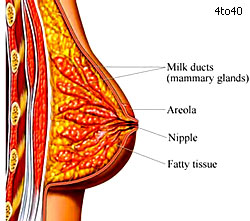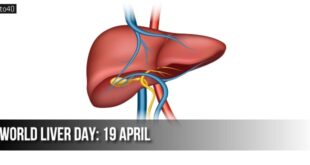Milk is produced in the mammary glands present in the breast. This glandular tissue is embedded in fat, giving the breast its round contours and size. The amount of glandular tissue in the breast is similar in amount in all women. Thus, milk production does not depend on the size of the breast.
 Milk production in the breast depends on the prolactin hormone secreted by the pituitary gland present in the brain. The pituitary gland releases prolactin when it receives sensory messages from the breast nerves that have been stimulated by the baby’s suckling. This hormone passes through the mother’s bloodstream to the breast epithelial cells to produce milk. Thus, the more frequent, vigorous and effective the baby’s suckling, the more is the amount of prolactin secreted and the more milk produced. The milk production is primarily regulated by the baby’s demand.
Milk production in the breast depends on the prolactin hormone secreted by the pituitary gland present in the brain. The pituitary gland releases prolactin when it receives sensory messages from the breast nerves that have been stimulated by the baby’s suckling. This hormone passes through the mother’s bloodstream to the breast epithelial cells to produce milk. Thus, the more frequent, vigorous and effective the baby’s suckling, the more is the amount of prolactin secreted and the more milk produced. The milk production is primarily regulated by the baby’s demand.
Factors enhancing milk production
- Suckling by the baby.
- Emptying of breasts.
- Expression of milk.
- Night feeds.
Factors that suppress prolactin production leading to low milk formation:
- Delayed feeds.
- Prelacteal feeds.
- Bottle feeding.
- Incorrect position during feeding.
- Painful breast conditions.
- Drugs like L-Dopa, ergot preparation and large amounts of pyridoxine.
The milk ejection reflex, or the sensation that milk is on the verge coming down, works under the influence of a hormone called oxytocin, which is secreted by the pituitary gland in response to the suckling stimulus. Oxytocin reaches the mother’s breast through the blood stream and causes the contraction of the smooth muscle cells in the breast, which eject the milk through the nipple.
Sometimes, the mother may feel the let down reflex, or the ejection reflex, even when the baby is actually not suckling. She may feel the let down reflex even on seeing, touching, hearing, smelling or even thinking about the infant.
The production of oxytocin is not entirely dependent on the suckling stimulus. Some amount of oxytocin is also secreted by the stimulation of other sensory pathways, like seeing touching or feeling.
On the other hand, a mother’s lack of confidence in her ability to breast feed, stress or embarrassment could interfere with this reflex. Thus, the most common cause for the failure of the ejection reflex is psychological inhibition.
How does the baby get his milk?
-
Rooting reflex helps the baby to locate the nipple when the mother’s breast touches the his lip, cheek or side of the mouth. He turns towards the stimulus, opens his mouth and searches for the nipple with an open mouth.
-
The suckling reflex helps the baby to draw out milk from his mother’s breast. The technique of suckling at the breast is very different from that used with a bottle nipple. A baby who has been fed with a bottle finds it difficult to suckle at the breast. Actually, even one or two bottle feeds can cause nipple confusion and interfere in successful lactation.
 Kids Portal For Parents India Kids Network
Kids Portal For Parents India Kids Network






